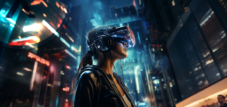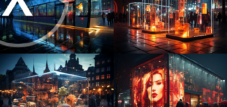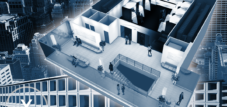Urbanization & Future: The 15-minute city concept with the Metaverse - refueling & shopping - Smart City & Home, Smart Charging
Language selection 📢
Published on: November 19, 2023 / update from: March 6, 2024 - Author: Konrad Wolfenstein
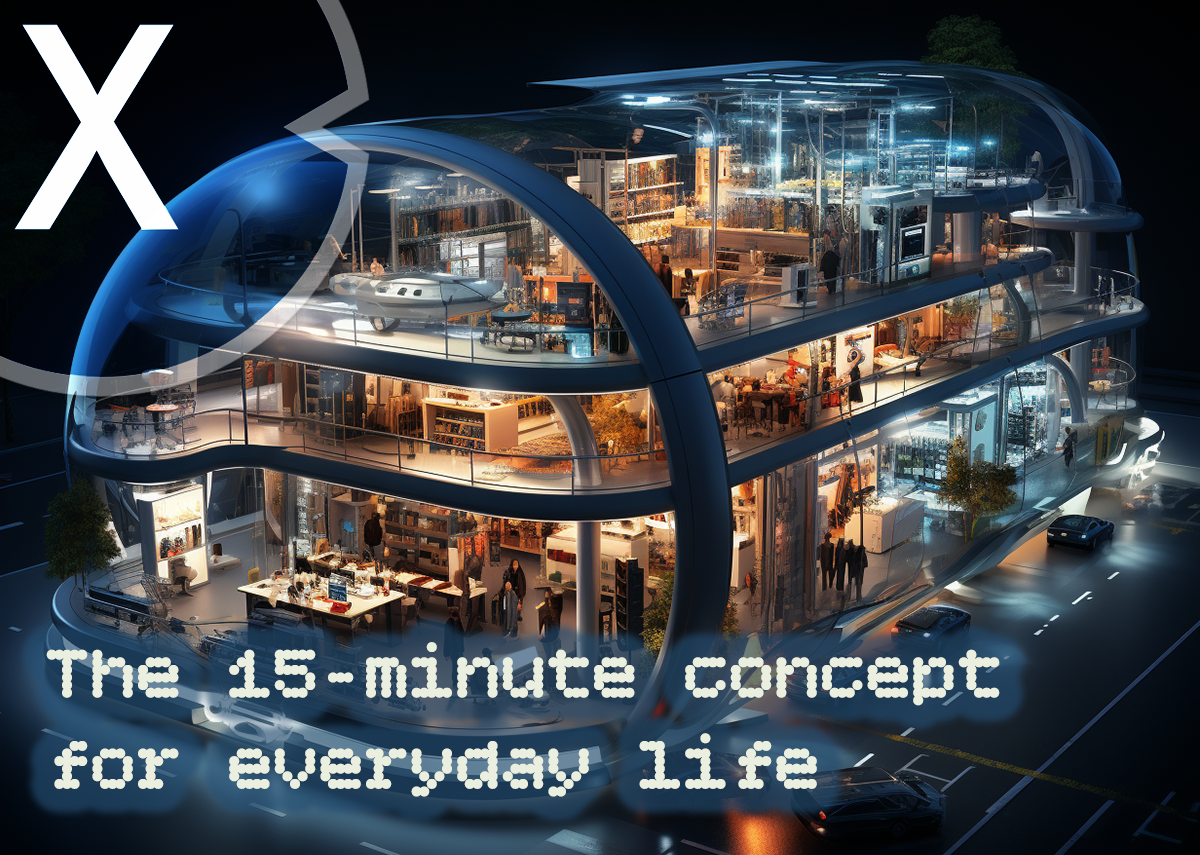
AI & XR 3D Rendering Machine: The city of the future - Achieve everything in 15 minutes - Living in harmony with mobility and comfort - Image: Xpert.Digital
🏙️🕒 The concept of the 15-minute city
The 15 Minute City concept is an advanced urban planning model that offers new ways to design urban living spaces by overlaying considerations of sustainability, technology and self-sufficiency. It represents a paradigm shift that redefines the understanding of mobility and urban supply in the 21st century. This vision emerges within the larger context of the move towards intelligent cities, also known as smart cities, which are characterized by the use of technology, data analytics and innovative infrastructures to create more efficient, inclusive and sustainable urban environments.
🏘️ Mixed neighborhoods and mobility
The central promise of the 15-minute city is relatively simple: all essential needs of daily life - work, shopping, education, healthcare and culture - should be accessible within a 15-minute walk or bike path or an equivalent public transport journey . This principle encourages the development of mixed neighborhoods that integrate both housing and commercial, cultural and recreational functions. This integrated approach aims to reduce long commutes, but also promotes social cohesion and a connected community.
🚲 Sustainable transport
In the 15-minute city, particular attention is paid to promoting emission-free or low-emission forms of mobility. Cities should be designed to minimize the need for private motor vehicles, which can reduce traffic congestion, air pollution and noise pollution. Pedestrian and bicycle paths will become the backbone of the urban transport network, complemented by reliable public transport that offers a fast and sustainable alternative to individual motorized transport.
🛠️ Technology and infrastructure
Implementing the concept requires a fundamental redesign of urban spaces. Emerging technologies such as vehicle autonomy and advanced traffic management systems play a key role here. In addition, technologies for renewing urban infrastructure enable emission-free and self-sufficient self-sufficiency. Solar panels, urban wind turbines and innovative waste recycling concepts help to reduce the ecological footprint and increase the resilience of cities to external influences such as energy crises.
🌱 Local food production and green spaces
Self-sufficiency in the 15-minute city goes even further. Urban agriculture, whether in the form of rooftop gardens, vertical farms or community gardens, can increase local food production and promote social cohesion while reducing the distance between production and consumption. This approach can significantly contribute to food security and reduce carbon emissions associated with transporting food.
🌼 Public space and quality of life
Another crucial aspect of the 15-minute city concept is the creation of public spaces that enable relaxation and encounters. Squares, parks and green belts not only serve for leisure and relaxation, but also support biodiversity and serve as green lungs within the urban landscape. The promotion of green spaces is central to improving urban quality of life and plays an important role in adapting to climate change, for example by improving temperature regulation in cities.
💡 Digitalization and citizen participation
Digitalization is also a key factor that has the potential to make the vision of the 15-minute city a reality. Data-driven urban planning enables the precise analysis of traffic flows and population densities, which in turn allows services and infrastructure to be planned and implemented according to needs. Digital platforms also make it easier for citizens to participate in planning processes and promote more democratic urban design.
🤝 Collaborative strategies and challenges
However, putting the principles of the 15-minute city into practice requires comprehensive, intersectional strategies that go beyond traditional urban planning approaches. City politicians, planning committees and civil society must work together in a collaborative process. This requires new regulations, incentive systems and investments that support the construction of essential infrastructure and contribute to the sustainable transformation of cities.
🌟 Quality of life and future developments
This could result in a significantly improved quality of life for the residents of such cities. By reducing commute times, people gain time back for themselves and their families. Urban density, combined with the transport transition and the creation of green spaces, can also contribute to a healthier and more active lifestyle.
🔄 Impact and outlook
Finally, the concept of the 15-minute city also comes with major challenges. It challenges traditional urban planning and requires a rethinking of ownership structures, commercial space and the prioritization of public space. Despite these challenges, the concept shows a promising path towards the future of urban life that focuses on sustainability and a sense of community and shows how technology can improve people's well-being.
📣 Similar topics
- 🌇🚶♀️ The 15-minute city: Creating sustainable urban living spaces
- ⏳🏙️ The concept of the 15-minute city: saving time in everyday life
- 🚲🌳 The 15-minute city: sustainable mobility and green spaces
- 🌍🏢 The 15-minute city: sustainability and self-sufficiency
- 🏢🚶♂️ Commutes to work in the 15-minute city: Short distances, better quality of life
- 🌿🌇 The 15-minute city: Green oases in the urban environment
- 🌐📱 The digitized 15-minute city: technology to improve lives
- 🔄🗣️ From traditional urban development to a 15-minute city: rethinking required
- 🌇🥦 The 15 Minute City: Urban Agriculture and Food Security
- 🧩🤝 Making the 15-minute city a reality: collaboration for sustainable transformation
#️⃣ Hashtags: #sustainability #city planning #mobility #green spaces #digitalization
🌍🏙️ Smart Cities - The solution for mega-urbanization?
The size of cities around the world is constantly increasing, fueled by the many millions of people who flow from the countryside into urban centers every year. But increasing urbanization is leading to growing demands on governments, companies and city administrations to manage the growing demand for goods and infrastructure in the centers. One solution is smart cities, which are paved by increasing global digitalization, automation and networking. But what are the trends and drivers of intelligent cities? Asia and especially Japan show where the future could lead in Europe.
More about it here:
⚡⌚ Smart Charging: 15-minute refueling in the context of the 15-minute city concept
🌆 The 15-minute city as a model of sustainable urban development
The concept of the 15-minute city goes back to the French scientist Carlos Moreno and describes an urban development model that aims to ensure that residents have all important daily amenities - work, shopping, education, healthcare and leisure - within 15 minutes on foot or you can reach it by bike. This approach promotes the local economy, reduces the need for long commutes, reduces traffic volumes and emissions and thus increases the quality of life.
🔌 Smart charging for electric vehicles
Smart charging, or intelligent charging, refers to systems that control and optimize the charging process of electric vehicles. It is a technology that uses real-time data to control charging according to various criteria such as electricity price, network capacity and user preferences. This can reduce costs, ensure grid stability and increase the proportion of renewable energies in the electricity mix.
🚗 The 15-minute refueling as part of the mobility transition
One of the biggest challenges in integrating electric vehicles into urban areas is the charging infrastructure. In order to increase user acceptance of electric vehicles, it is essential to offer a quick and easy charging option. “15-minute refueling”, i.e. the ability to charge an electric vehicle enough to achieve an acceptable range for daily needs in around 15 minutes, is considered a breakthrough for electromobility.
🛠️ Implementation and challenges
Investments in infrastructure and technology are required to establish a comprehensive network of fast-charging stations for 15-minute refueling. Cities must work with energy suppliers and private companies to install and maintain the necessary charging infrastructure.
🤝 Collaboration for the transport transition
A critical prerequisite for the success of both concepts - the 15-minute city and the 15-minute refueling - is close cooperation between city planners, energy suppliers, automobile manufacturers and citizens.
🎉 15:Minute refueling
The interaction of the 15-minute city and the 15-minute refueling can make a significant contribution to achieving climate goals and improving the quality of life in urban areas. It requires a holistic view of urban planning, mobility, energy supply and consumer behavior.
📣 Similar topics
- ⚡🚗 The future of mobility: Smart charging in the 15-minute city
- 🌆🔋 Sustainable urban development: The concept of the 15-minute city with smart charging
- 📈🔌 Smart Charging: The efficient charging technology for the 15-minute city
- 🚗⌛ 15 minutes to full battery: Fast charging in the 15 minute city
- 💡🔌 Smart Charging in the 15-minute city: Shaping sustainable mobility
- 🏙️⚡ The 15-minute city and smart charging: urban living in harmony with the environment
- 🚀🔋 The future of electromobility: 15-minute refueling in the Smart City
- 🏞️⚡ 15 minute charge and go: Fast charging infrastructure for the 15 minute city
- 🌍🚗 Sustainable mobility in the 15-minute city: Smart charging for the environment
- 🏙️💡 The 15-minute city: Smart charging as the key to a sustainable future
#️⃣ Hashtags: #SmartCharging #SustainableMobility #15MinuteCity #Electromobility #Innovation
🏙️📦🏢🌳 Logistics with urban planning and urban development: The logistic trick for more space - for more recreation areas in cities | Smart City
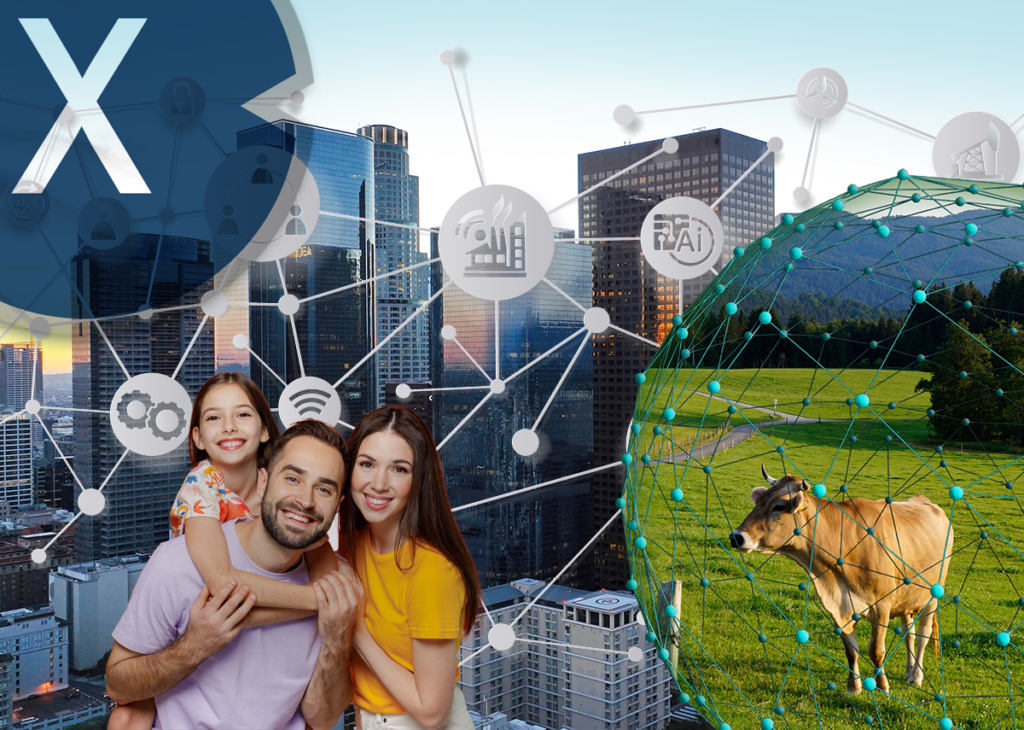
The logistical trick for more space – for more recreation areas in cities – Logistics & Urban Planning – Image: Xpert.Digital
In almost all city and urbanization concepts, the focus is on administration, IT, energy and mobility. When evaluating smart cities according to the Smart City Index, administration, IT, energy, mobility and society are analyzed. A particular focus is on the last meters of the global supply chain, also known as last mile logistics, which are particularly sensitive. Concepts like Citiverse and Smart City Metaverse are enthusiastic about integrating the virtual world into reality. Building-integrated photovoltaics (GIPV) are intended to develop alternative renewable energies and help city planners to densify inner cities in a socially acceptable way. Business, offices, shops and the flow of goods in increasingly dense cities are burning topics.
More about it here:
🌐🌆 The Potential of the Metaverse and the 15 Minute City 🏙️
🌐🚀 Metaverse and 15-Minute City: Opportunities and Challenges
The potential of the metaverse to bring the concept of the 15-minute city to life is fascinating. It opens up the possibility of elegantly and seamlessly complementing and overcoming the insurmountable obstacles of the real world with a virtual world.
🚶♂️ The 15-Minute City: A New Urban Planning Model
The 15 Minute City represents a paradigm shift in urban planning, where the goal is for all essential needs of daily life to be within 15 minutes walking or cycling distance. This concept not only promotes efficiency and sustainability, but also the quality of life of the residents. It helps reduce traffic congestion, reduce carbon emissions and promote social interaction.
🤖 The Metaverse as a tool for urban solutions
The Metaverse could serve as a tool that overcomes the obstacles to this vision. By using the Metaverse as a virtual environment, people can access work, education, shopping, and many other offerings from the comfort of their own home without actually being physically present.
🏪 Overcoming physical distances in the Metaverse
One of the challenges of the 15-minute city is that not all facilities and services are available in close proximity to a residential area. This can be overcome through the metaverse by creating a virtual representation of these services and offerings. Users could visit virtual stores, take online courses or attend virtual meetings to experience the 15-minute city in their own home.
🚘 Reducing traffic through the metaverse
In addition, the Metaverse offers the possibility of reducing traffic volumes in the city. Rooms in the Metaverse allow people to perform some activities that normally require physical presence virtually. This reduces the need for private vehicles, which reduces traffic congestion and reduces environmental impact.
🌳 Positive impact on urban infrastructure and the environment
Integrating the metaverse into the concept of a 15-minute city would also have positive impacts on the infrastructure. Instead of providing huge parking spaces for cars, these areas could be used for green spaces or parks. This would not only increase urban greenery, but also improve residents' quality of life and create space for recreation and community.
👥 Virtual communities and social cohesion in the metaverse
Another important aspect is the creation of virtual communities and social cohesion. The Metaverse could serve as a platform for people in the 15-minute city to interact with each other, whether in virtual neighborhoods or at shared events. It would strengthen the feeling of belonging and community, even if the encounters take place virtually.
⚠️ Accessibility and the digital divide
However, alongside the obvious benefits, there are also challenges in implementing the metaverse as the basis for a 15-minute city. On the one hand, a reliable internet connection is required to enable seamless interaction in the virtual world. This is not yet the case across the world and could lead to a further digital divide.
🏞️ Balanced use of physical and virtual spaces
Another challenge is finding a balanced use of physical and virtual spaces. It is important to ensure that the integration of the metaverse into urban planning does not lead to a loss of social meeting places and alienation of residents. Creating hybrid spaces that enable both physical and virtual interactions could provide a solution to this problem.
🔒 Data protection and privacy
Data protection and privacy are other important aspects when using the metaverse. It is critical that users' personal information is protected and that they have control over how their information is used. Transparent privacy policies and robust security measures are critical to gaining user trust in the Metaverse.
🌐 Social and cultural integration
In addition to the technical challenges, social and cultural aspects must also be taken into account. People's acceptance and willingness to engage with the Metaverse as part of their daily lives is crucial. Education and outreach activities can help promote understanding and use of the metaverse.
💭 Vision of a sustainable city
The concept of the 15-minute city combined with the Metaverse offers an exciting vision for the cities of the future. It shows how digital technologies can be used to improve quality of life, reduce environmental impact and promote social interactions. However, implementing this concept requires careful planning, technological innovation and the creation of social consensus.
🔄 Merging virtual and real worlds
The combination of physical and virtual spaces could usher in a new era of urban planning that focuses on the needs of residents and makes cities sustainable and livable. Incorporating the metaverse into the conception of a 15-minute city opens up a variety of possibilities and presents us with challenges that we must actively address. This is the only way we can successfully merge the virtual and real worlds and realize the concept of the 15-minute city.
📣 Similar topics
- 🌍🏙️ Connecting the Metaverse and 15 Minute City
- 🌱🔗 The potential of the metaverse for urban concepts
- 💻🏘️ Virtual solutions for the 15-minute city
- 🚗🌐 The role of the metaverse in traffic reduction
- 🌳🏗️ The metaverse and sustainable city infrastructure
- 💻👥 Virtual communities in the 15 minute city
- 🌍🔗 Breaking Barriers: The Metaverse and the 15-Minute City
- 📈🏢 The Metaverse as a tool for efficient cities
- 🌐🚗 The Metaverse as an alternative to private transport
- 🏙️📱 The Metaverse and the Future of Urban Planning
#️⃣ Hashtags: #Metaverse #15minutescity #cityplanning #sustainability #virtualcommunities
📦🚚💡 How micro-hubs and micro-fulfillment logistics centers drive smart city solutions for spare parts logistics and consumer goods logistics | Metaverse

Smart City Logistics solutions with micro-hubs and micro-fulfillment logistics centers – Image: Xpert.Digital / metamorworks|Shutterstock.com
Micro-fulfillment logistics refers to an innovative method of order fulfillment and delivery of goods in e-commerce that uses small, localized storage and processing units. The goal of the micro-fulfillment approach is to enable quick and efficient fulfillment of online orders, especially in urban areas where space is limited.
More about it here:
🌐✨ Metaverse and Administration: Redesigning City Administration - An example with authorities
🌐💡 Metaverse: New paths to citizen participation and democratization
The concept of the 15-minute city has always been an interesting approach and an exciting challenge. It aims to make the crucial areas of daily life accessible within 15 minutes and is both a utopia and a motivator for new solutions and goals. But with the emergence of the metaverse, possibilities open up that easily overcome previous apparent hurdles and impossibilities.
🌐 The Metaverse and overcoming spatial-temporal boundaries
The Metaverse offers a new dimension in which natural limitations of space and time almost disappear. Official procedures can be completed digitally, eliminating the need to look for parking spaces in crowded cities or wait in endless lines. Artificial intelligence (AI) can clarify all the necessary details in advance, so that a real person in the virtual world is only needed for the formal and legally correct approval of the application or process. This saves time, ensures accessibility for everyone (both physical and virtual) and makes optimal use of human resources.
💼 AI and increasing efficiency in administrative processes
Integrating AI into administrative processes enables increased efficiency and conserves limited human resources, especially at a time when staff shortages and work-life balance play an important role.
🤖 Expansion through AI in the Metaverse
The use of AI in the Metaverse complements and expands personnel know-how. AI can access extensive knowledge and algorithms and can therefore handle complex tasks. It can process requests, provide information, and even make intelligent decisions. This leads to increased professionalism and effectiveness of administrative processes.
🤝 Improving cooperation in the metaverse
Another advantage of the metaverse is that it improves collaboration and communication between authorities, companies and citizens. Virtual platforms make it easier to share information and process processes more quickly. The barriers of space and time are removed, resulting in simplified collaboration and effective solutions.
🔒 Data security and data protection in the digital space
A central aspect of the digital government service in the metaverse is the security of data and the privacy of users. The use of advanced encryption technologies and strict privacy policies ensure that citizens' personal information is protected. This creates trust and enables seamless integration of the virtual government service into people's everyday lives.
🗣️ Citizen participation and decision-making processes
The metaverse also offers opportunities for citizen participation and democratization of decision-making processes. Through participatory platforms, citizens can contribute their opinions and suggestions and thus actively participate in shaping administrative decisions. This strengthens the transparency of government activities and promotes trust between the government and citizens.
⚠️ Challenges of digitalization
However, there are also challenges to consider when transitioning to digital government services in the metaverse. It is important to ensure that all citizens have access to digital technologies and that no one is excluded due to technical barriers. Furthermore, government systems must be vulnerable to cyberattacks and data loss, so appropriate security measures must be implemented.
🎓 Education and preparation for digital change
Another point that should be taken into account is the need to prepare people for digital transformation and train them in the possibilities of using the metaverse. Education programs and training can help strengthen citizens' digital literacy and ensure that everyone can benefit from the benefits of digital government services.
🔗 Integration of technology and management
Overall, the metaverse offers a promising perspective for digital government services. It enables more efficient, accessible and user-friendly administration as well as improved citizen participation in decision-making processes. By integrating AI and advanced technology, digital government service in the metaverse can lead to better administration that is timely, resource-efficient and effective.
🏘️ 15 Minute City and Metaverse: A New Era of Urban Development
The visionary idea of the 15-minute city can become a reality through the use of the metaverse. It offers the opportunity to combine the best of both worlds and create a more efficient, accessible and sustainable urban environment. By integrating technology into urban space, we can usher in a new era of urban planning and development that meets people's needs and promotes community well-being.
🔮 Future vision: The implementation of the Metaverse in our cities
Ultimately, it is up to us to recognize the opportunities presented by the metaverse and harness them to create innovative solutions and improve our cities. It requires collaboration, technology adoption and a bold step into the future of digital government. By harnessing the possibilities of the metaverse, we can bring the 15-minute city closer to reality and create a better quality of life for everyone.
📣 Similar topics
- 🌐 The metaverse and the digital government service
- 💻 The future of government services: The Metaverse as a solution
- 🏢 The benefits of the metaverse for management
- 🌍 The Metaverse: A new dimension for government services
- 🔐 Data protection and security in digital government services in the metaverse
- 🤝 Improved collaboration in the metaverse for authorities, companies and citizens
- 📚 Digital literacy and education programs for the metaverse
- 🌆 The 15-Minute City in the Metaverse: A sustainable vision becomes reality
- ⚡️ Increasing efficiency through AI in the Metaverse
- 🚀 The opportunities and challenges of digital government services in the metaverse
#️⃣ Hashtags: #Metaverse #DigitalAdministration #Citizen Participation #Data Protection #Efficiency
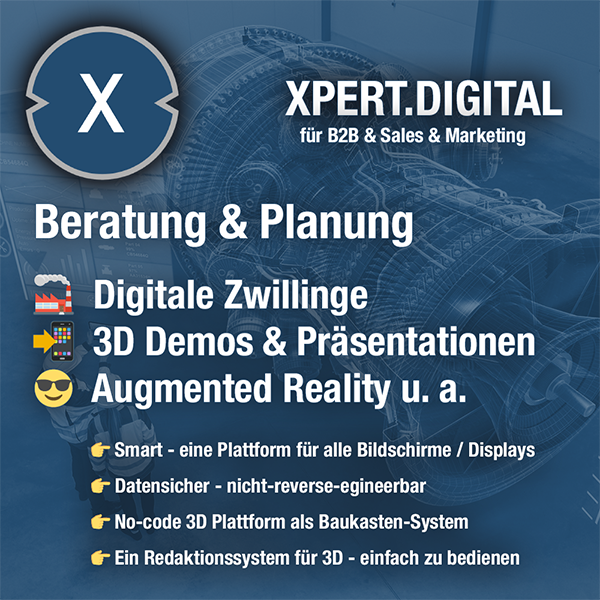
Industrial & B2B Business Metaverse: Reduce costs with XR technology for photorealistic product images (XR 3D rendering machine)
XR technology offers a superior solution for creating photorealistic images and allows companies to free themselves from the expensive fees of external media agencies. It is common knowledge that media agencies charge high costs to create such images as it requires expertise, special software and collaboration with various experts.
More about it here:
Plan your solar system for the most common applications conveniently online with our solar system planner!
With our user-friendly solar system planner you can plan your individual solar system online. Whether you need a solar system for your home, your business or for agricultural purposes, our planner offers you the opportunity to take your specific requirements into account and develop a tailor-made solution.
The planning process is simple and intuitive. You simply enter relevant information. Our planner takes this information into account and creates a tailor-made solar system that meets your needs. You can try out different options and configurations to find the optimal solar system for your application.
Additionally, you can save your plan to review later or share with others. Our customer service team is also available to answer your questions and provide support to ensure your solar system is optimally planned.
Use our solar system planner to plan your individual solar system for the most common applications and advance the transition to clean energy. Start now and take an important step towards sustainability and energy independence!

The solar system planner for the most common applications: Plan the solar system online here - Image: Xpert.Digital
More about it here:
We are there for you - advice - planning - implementation - project management
☑️ Smart City & Factory: Industry expert for energetic 5G buildings and halls as well as advice and installation of solar systems
☑️ Xpert.Plus - logistics consulting and logistics optimization
☑️ Industry expert, here with his own Xpert.Digital Industry Hub with over 1,500 specialist articles
I would be happy to serve as your personal advisor.
You can contact me by filling out the contact form below or simply call me on +49 89 89 674 804 (Munich) .
I'm looking forward to our joint project.
Xpert.Digital - Konrad Wolfenstein
Xpert.Digital is a hub for industry with a focus on digitalization, mechanical engineering, logistics/intralogistics and photovoltaics.
With our 360° business development solution, we support well-known companies from new business to after sales.
Market intelligence, smarketing, marketing automation, content development, PR, mail campaigns, personalized social media and lead nurturing are part of our digital tools.
You can find out more at: www.xpert.digital - www.xpert.solar - www.xpert.plus










